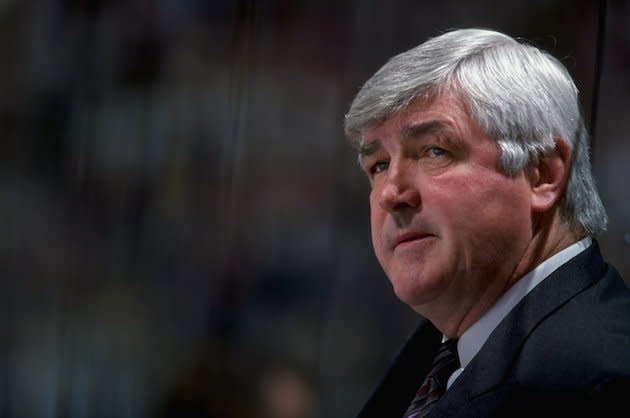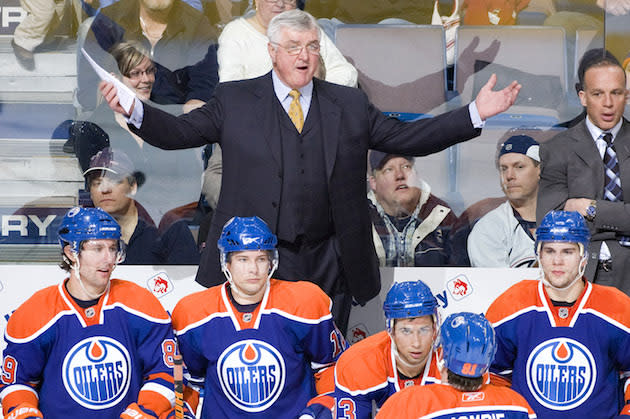Former players, teammates remember Pat Quinn, Hockey Hall of Famer

Nearly two years after he passed away at the age of 71, Pat Quinn will be inducted into the Hockey Hall of Fame.
The big Irishman coached five NHL teams over a span of 32 years and collected 684 wins, won two Jack Adams Awards and made two trips to the Stanley Cup Final. He was also behind the bench for Team Canada at two Olympics, a World Cup, a Spengler Cup and the U-18 and U-20 World Junior Championships and brought home three gold medals and the 2004 World Cup title.
While many remember Quinn as a hockey coach, he also had a long career as a player, suiting up for 606 NHL games with the Toronto Maple Leafs, Vancouver Canucks and Atlanta Flames.
The transition from player to coach went smoothly for Quinn, who had to retire from playing due to an ankle injury. Two years after hanging up his skates, he coached the Philadelphia Flyers during a memorable season where they went 35 games without a loss and reached the Final. That run would earn him his first coach of the year award.
Quinn touched many lives during his hockey life. We reached out to a few who crossed paths with him to collect their memories about the Hockey Hall of Famer.
THE TEAMMATE
Before he went into broadcasting, Bill Clement spent parts of two seasons playing in Atlanta with Quinn and admired his captain greatly.
“Pat was fiercely competitive as a player and was also extremely protective of his teammates. Always there for you.”
Dale Tallon was a No. 2 overall pick when he entered the league during the 1970-71 season with the Vancouver Canucks. He was the youngest player on that team, and the older, wiser Quinn acted as a mentor to his fellow defenseman.
“He’s the best teammate I played with. He took me, I was only a kid, and he was really a tremendous mentor for me and helped me on and off the ice. He just turned me into a real pro. I looked up to him and I admired the guy. He was a great friend and a great mentor.”
THE MOTIVATOR
Bret Hedican was dealt from the St. Louis Blues to the Canucks during the 1994 NHL Trade Deadline. He was 24, and this was the first time in his career he had been dealt. His confidence was a bit shaken, and Quinn sensed that.
One day, he summoned Hedican to his office, knowing he needed to get his new defenseman’s head straight following the trade. He told Hedican to keep it simple and not to overdo it, and to use one of his best assets, his skating ability, to his advantage to quickly get the puck and move it out of the zone.
[Winding road finally leads Eric Lindros to Hockey Hall of Fame]
The chat helped clear Hedican’s head and rebuild his confidence. The Canucks would come within a game of winning the 1994 Stanley Cup, and that conversation early in his Vancouver career would stick with Hedican for another 14 NHL seasons.
Quinn had a way with words when dealing with his players and trying to inspire them, Hedican recalls.
“I have so many memories of Coach Quinn, but one that will always be etched in my mind is Game 5, first round of the 1994 Stanley Cup Playoffs vs. the Calgary Flames. We were down 3-1 [in the series] and this was an elimination night, where Calgary could close us out on their home turf.
“I remember Pat walking in the locker room before the game and putting a piece of paper on the wall that he wanted us all to read. The paper talked about three teams that had been down 3-1 in the opening round and came back to win that series and go on to win the Stanley Cup. After we all had read the paper Pat came in to say, ‘Many teams truly don’t know how close they are to winning a Stanley Cup because many give up when they’re in this situation. What was different about those three teams? The difference is that those three teams believed they could win. Those three teams had the individuals that wouldn’t quit no matter what. Those three teams committed to believing in the way they played and in each other. I believe, WE ARE ONE OF THOSE TEAMS!’
“Well, we went on to win that Game 5 in Calgary, Game 6 in Vancouver, and then Game 7 back in Calgary. To this day, that might have been one of the toughest playoff series I’ve ever been associated with. Pat was right. We were one of those teams. We went on to lose in the Final that year to the New York Rangers, but had we not believed in that first round being down 3-1 we would had never had that opportunity to play in a Game 7 for the Cup. It’s amazing when you have a coach like Pat, who can guide you to believe in yourself and your teammates when sometimes you don’t know.”
THE HUMOR
The 2009-10 NHL season was one to forget for the Edmonton Oilers. Four years after reaching Game 7 of the Cup Final, they finished dead last in the NHL with 62 points. There were a lot of nights to forget that year, but as Patrick O’Sullivan, a forward on that team, recalled, Quinn knew how to lighten the mood.
“He confused Ovechkin for Kovalchuk one night during a PK meeting when Washington was in town — just a slip of the tongue that happens to everyone from time to time. He mentioned it like five times, though, so guys are starting to snicker a little bit. He finally realized at the end what he was doing and he said, ‘’Ah f— it, either one of them will probably light us up, so what’s the difference?
“The entire room erupted with laughter, had other coaches and all the players in the video room in tears.
“When you’re dead last and having a tough year the NHL can be a grind like no other and Pat could always have fun with it, which to me is who he really was: A guy who loved his players, and a guy who was a true NHL lifer.”

THE STRAIGHT SHOOTER
Even when his teams were bad, Quinn stressed the importance of team unity. He wanted his players to have each other’s backs, and as O’Sullivan recalled, when times got tough, you always knew where you stood with the coach.
“The most memorable thing that comes to mind when playing for Pat is that he always wanted guys to compete and take care of each other on and off the ice. We were garbage in 2009-10, the worst team in the league, but we managed to stay close as a group and that had a lot to do with Pat.
“I had a few disagreements with him over the year, but he was always honest. He’d tell you were terrible on a certain game and he’d tell you what you had to do to be better. Not enough coaches are direct like that. Pat didn’t play mind games, and as a player that’s all you want.”
THE PRESENCE
A 6-foot-3, Quinn could be intimidating. At that size and owning an Irish temper, he could be really intimidating. He used both of those to his advantage when he needed to give his teams a kick in the butt. Hedican remembered one night with Vancouver where the defenseman-turned-head coach had enough of his forward group not working hard enough.
“Because he was a defenseman when he played in the NHL, he was always a little more sympathetic towards what we went through playing defense. He realized in order for us to do our job it took the commitment of our forwards to be available for us to move them the puck.
“One night, shortly after my trade from St. Louis, it was a night where our forwards were essentially being lazy and not working hard enough to get back and support us on the breakout or in the defensive zone. Most coaches would have maybe let it slide or not recognized the laziness of our forwards and thought it was the defense’s problem of not moving the puck efficiently. Well, not Coach Quinn. I remember him coming into the locker room after the first period and his big Irish head looking like it just might blow off the top of his neck.
“There was a white board that had the layout of the rink and he began his rant looking directly at all the forwards. He began, ‘How do you forwards expect to get the puck when you don’t even work to get back to protect the ‘house’ (place in front of our net)?’ At that point he took his fist, which reminded me of a sledgehammer I have in the garage, and slammed it into the white board in front of our net, in the slot, as he shouted, ‘If you forwards don’t start skating back to the house hard, and then sprinting to the boards to get open, I’ll be sure that tomorrow in practice you will!’
“At that moment of him slamming his fist into the white board, the white board completely caved in and succumbed to the pure force of Pat’s fist. I can remember us D all had a slight smile on our face, but knew we couldn’t laugh, and the forwards had a look of pure fear. The rest of that game I have never seen forwards work so hard to get back into our defensive zone to get open. It was truly one of the moments in my life where I saw a coach hold people accountable to the job that is expected of them.
“Pat was the first coach that showed me what the word accountability meant. Without it, you have nothing. Without it, you don’t have a team. But because Pat knew this, he was able to get great things out of individuals like me, and get teams to exceed their expectations.”
THE PERSON
Quinn may have owned an Irish temper, but he knew how to treat his teammates and players. He understood that the player/coach, teammate/teammate relationship is vital for success.
“What was impressive was how loyal his players were to him,” said Clement. “They all were able to sense how much he cared about them.”
“How he treated people. Nothing changed with him,” said Tallon in regard to how Quinn’s demeanor changed when he transitioned into coaching. “He treated people always the same no matter what kind of player they were. He had a balance about him and a real good control. He just had a real good way about him that made you comfortable around him and made you want to go through the end wall for him.
“He was one of those guys that really got the best out of you every time.”
– – – – – – –
Sean Leahy is the associate editor for Puck Daddy on Yahoo Sports. Have a tip? Email him at puckdaddyblog@yahoo.com or follow him on Twitter! Follow @Sean_Leahy

